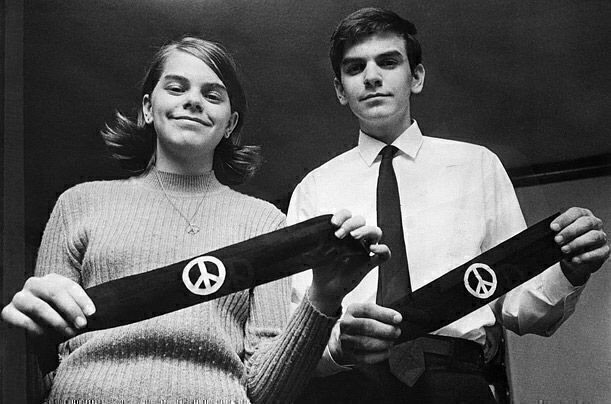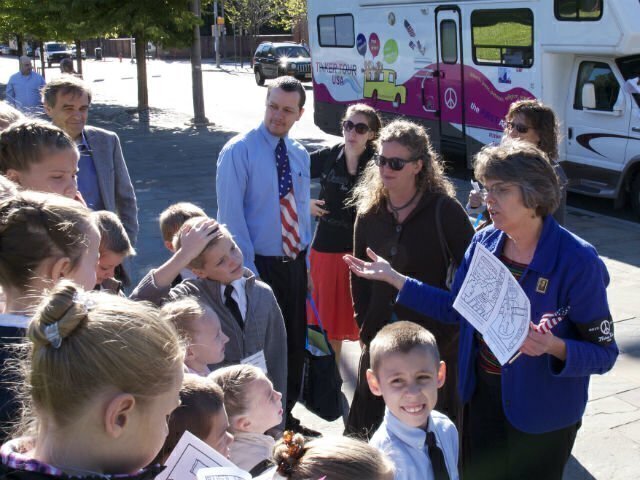
Mary Beth and John Tinker
* Editor's Note: The Tinker case is featured in the National Constitution Center's 2017 Civic Calendar, which you can download here.
On February 24, 1969, the Supreme Court ruled in Tinker v. Des Moines Independent Community School District that students at school retain their First Amendment right to free speech.
The story of this landmark case begins four years prior, during the early wave of protests against the Vietnam War. Public demonstrations and university “teach-ins” were growing in response to a rising death toll and increasing doubts about the motives and goals of the war.
Enter Mary Beth Tinker, a 13-year-old student at Warren Harding Junior High School in Des Moines, Iowa. Her story is recounted with care in Peter Irons’ The Courage of Their Convictions: Sixteen Americans Who Fought Their Way to the Supreme Court, the primary source for this discussion.
On December 16, 1965, Tinker wore a black armband to school to protest the war in Vietnam and to mourn the hundreds of soldiers killed in action—a number that would approach 60,000 by war’s end, in addition to many tens of thousands more wounded or missing. After lunch, Tinker was called to the principal’s office, at which point she was suspended for violating a district ban on such armbands. By week’s end, four other students across the district—her brother John, Christopher Eckhardt, Christine Singer, and Bruce Clark—were also suspended.
The controversy made the front page of The Des Moines Register. The school board president, Ora Niffenegger, defended the ban as a “disciplinary measure” against “disturbing influence” in school. “Our country’s leaders have decided on a course of action,” said Niffenegger, “and we should support them.”
The Iowa Civil Liberties Union saw things differently. At a school board meeting on December 21, attorney Craig Sawyer insisted that the students be reinstated and the armband rule be repealed. Other members of the community also spoke, representing views on both sides of the debate. Yet no resolution emerged. When a board member tried to end discussion, Sawyer cried out, “I am demanding that you decide it. Take a stand! That’s what you’re here for.” Indeed, they did: The board voted 5-4 to maintain the ban. The dispute was headed to court.
In the first round, the students lost. On September 1, 1966, Chief Judge Roy Stephenson of the U.S. District Court for the Southern District of Iowa upheld the prohibition against armbands. Despite acknowledging that wearing an armband is a “symbolic act” that falls under the Free Speech Clause of the First Amendment, Judge Stephenson determined that the school district’s concern for “the disciplined atmosphere of the classroom” outweighed speech concerns. Later, the U.S. Court of Appeals for the Eighth Circuit was evenly divided. The case was appealed to the U.S. Supreme Court.
The Court heard arguments on November 12, 1968. Dan Johnston, arguing for the students, pointed out that the district had allowed other kinds of provocative political speech, including buttons reminiscent of the Nazi regime, and that no disruption of school activities had occurred. Allan Herrick, arguing for the district, insisted that the board be allowed to preempt the “violence, disorder, and disruption” that could “break out” in response to such provocations.
Here, at the highest level, the students won. Writing for a 7-2 majority, Justice Abe Fortas issued the now-famous declaration that students and teachers do not “shed their constitutional rights to freedom of speech or expression at the schoolhouse gate.” Student speech can’t be censored, he wrote, unless it “materially disrupts classwork or involves substantial disorder or invasion of the rights of others.”
He went on:
Under our Constitution, free speech is not a right that is given only to be so circumscribed that it exists in principle, but not in fact. Freedom of expression would not truly exist if the right could be exercised only in an area that a benevolent government has provided as a safe haven for crackpots. The Constitution says that Congress (and the States) may not abridge the right to free speech. This provision means what it says. We properly read it to permit reasonable regulation of speech-connected activities in carefully restricted circumstances. But we do not confine the permissible exercise of First Amendment rights to a telephone booth or the four corners of a pamphlet, or to supervised and ordained discussion in a school classroom.
In a very brief concurrence, Justice Potter Stewart challenged the idea that children are entitled to the same degree of First Amendment protections. But the real heat came from Justice Hugo Black, whose blistering dissent insisted that the students’ armbands had, in fact, disrupted school activities—despite no clear evidence to that effect—and decried “the beginning of a new revolutionary era of permissiveness in this country fostered by the judiciary.”
He explained:
Change has been said to be truly the law of life, but sometimes the old and the tried and true are worth holding. The schools of this Nation have undoubtedly contributed to giving us tranquility and to making us a more law-abiding people. Uncontrolled and uncontrollable liberty is an enemy to domestic peace. … One does not need to be a prophet or the son of a prophet to know that, after the Court's holding today, some students in Iowa schools—and, indeed, in all schools—will be ready, able, and willing to defy their teachers on practically all orders.

Since Tinker, Justice Black has been vindicated, if only partially. In a series of important cases—Bethel School District No. 403 v. Fraser (1986), Hazelwood School District v. Kuhlmeier (1988), and Morse v. Frederick (2007), the Supreme Court has chipped away at Tinker’s commitment to a student’s First Amendment rights. Significant questions remain as to whether and to what degree a school can punish students for speech expressed off-campus or online.
Even so, Mary Beth Tinker is still fighting. At the National Constitution Center on Constitution Day 2013, she launched her “Tinker Tour” to promote “youth voices, free speech and a free press.” The tour continues.
Nicandro Iannacci is a web content strategist at the National Constitution Center.







